
Eco-Friendly Materials vs Traditional Choices in Home Builts
Many homeowners face the tough choice between eco-friendly materials and traditional options for their new builds. Sustainable design is not just a trend; it contributes to both the environment and personal well-being. This article will explore the environmental impact of traditional materials, identify key eco-friendly choices, and discuss how custom home builders can lead the way in promoting sustainable practices. Readers will learn how to make informed decisions that enhance their spaces, like kitchens and bathrooms, and ensure healthier living environments. Understanding these factors can help solve the dilemma of selecting the right materials for a home’s landscape.
Key Takeaways
Custom home builders can significantly reduce environmental impact by selecting eco-friendly materials.
Sustainable building methods like passive house designs lead to lower energy costs and pollutants.
Using natural fibers for insulation improves air quality and enhances energy efficiency in homes.
Financial incentives encourage homeowners to choose eco-friendly construction options for long-term savings.
Certified green builders prioritize sustainability, reducing greenhouse gas emissions in custom home construction.
Understanding Sustainability in Home Design

Sustainability in home design focuses on reducing environmental impact. Custom home builders are crucial in selecting materials that minimize waste during construction and demolition. Using eco-friendly options makes the building process more efficient and less harmful to the planet.
One effective approach to sustainable building is the passive house design. This method emphasizes energy efficiency through proper insulation and strategic window placement. By reducing the reliance on heating and cooling systems, a passive house can significantly lower energy costs and limit pollutants in the home.
Factory-built homes often utilize eco-friendly materials, which further support sustainability. These homes can be constructed with minimal waste and set up quickly, lessening the environmental impact. Builders can create functional and responsible homes by choosing smart materials and efficient designs.
Evaluating the Environmental Impact of Traditional Materials

Traditional building materials often have a significant environmental footprint. Common choices, such as concrete and steel, require extensive energy to produce, leading to higher carbon emissions. This impacts the natural environment, making it essential for builders to assess alternatives.
In contrast, eco-friendly materials can support sustainable energy systems. For instance, integrating materials that work alongside geothermal heating or solar power reduces a home's energy needs. This creates a smaller environmental impact and contributes to responsible custom home building.
Choosing traditional materials may seem cost-effective initially, but long-term effects can negate savings. Higher energy costs and increased maintenance due to inefficiencies can arise. By evaluating the environmental effects, builders can make informed decisions that promote sustainability:
Identifying Key Eco-Friendly Materials for Home Building

Bamboo and cork are gaining popularity among home builders due to their sustainability and energy efficiency. Recycled steel and plastic also serve as strong materials, minimizing waste and promoting green building techniques. Techniques like rammed earth and straw bale construction offer unique advantages, such as excellent insulation and resilience against wildfire. Understanding these options helps homeowners make informed decisions for their custom homes.
Benefits of Bamboo and Cork in Construction
Bamboo and cork offer significant benefits in construction that help combat climate change while providing sustainable options. Both materials are renewable and can be harvested without damaging the ecosystems they come from. A general contractor may recommend using bamboo as an eco-friendly lumber choice for walls because it grows quickly and absorbs carbon dioxide, making it a strong ally in reducing greenhouse gases.
Bamboo is a rapidly renewable resource.
Cork comes from the bark of cork oak trees without harming the tree.
Both materials help lower carbon footprints in custom-built homes.
Using these materials can support eco-conscious building practices while creating durable and attractive spaces.
The Role of Recycled Steel and Plastic
Recycled steel and plastic play essential roles in building sustainable homes. By choosing these materials, builders reduce waste while maintaining strength and durability. For instance, recycled steel can be used in water heaters and structural frameworks, providing energy-efficient solutions that enhance both ventilation and beauty in home design. Emphasizing biophilic design, these materials help create inviting spaces that connect with nature, all while supporting eco-friendly practices.
Advantages of Rammed Earth and Straw Bale Techniques
Rammed earth and straw bale techniques present valuable advantages in sustainable building for custom homes. These building materials are highly effective at reducing the effects of climate change, as they utilize natural resources that are often renewable. Rammed earth provides excellent thermal efficiency, helping to manage indoor temperatures and reduce energy consumption. At the same time, straw bales offer great insulation properties, leading to lower heating and cooling costs for homeowners. By choosing these materials, builders can create homes that align with sustainability goals while addressing the increasing demand for eco-friendly construction practices.
Comparing Longevity and Maintenance of Eco-Friendly vs Traditional Materials

When discussing green home construction, longevity often becomes a key factor. Eco-friendly materials typically offer impressive durability, which can lead to less frequent replacements. This characteristic reduces waste that might otherwise end up in a landfill, making these choices an environmentally sound option.
Maintenance requirements also differ between traditional and eco-friendly materials. While traditional materials like concrete may need regular upkeep to manage wear, green options like a well-constructed green roof can significantly reduce maintenance. This efficiency saves time and supports a stronger building envelope, further enhancing energy conservation.
Innovation in building methods allows for eco-friendly solutions to outperform traditional choices in many aspects. By incorporating sustainable materials, builders can create resilient structures that withstand the test of time. This commitment to durability and lower maintenance needs aligns with the goals of green home construction, cultivating a more responsible approach to housing development.
Exploring Cost Implications of Sustainable Building Materials

Initial investments in sustainable building materials may be higher than traditional choices, yet long-term energy consumption and maintenance savings can outweigh these costs. Financial incentives for eco-friendly construction, such as tax credits and lower utility bills, make options like Deltec Homes attractive. Understanding the impact on the carbon footprint, irrigation needs, and thermal insulation helps homeowners make informed decisions that benefit both their wallets and the environment.
Initial Investment Versus Long-Term Savings
Investing in eco-friendly materials, such as those found in a custom home build, may require a higher upfront cost than traditional choices like steel. However, this investment can lead to long-term savings through reduced energy bills, especially when incorporating features like passive solar design and materials certified by Energy Star. Homeowners can benefit from lower utility costs and greater resilience against challenges like flood damage, making eco-conscious choices a financially wise option over time.
Financial Incentives for Eco-Friendly Construction
Home builders can access various financial incentives to promote eco-friendly construction, which can significantly affect overall costs. Tax credits and rebates for energy-efficient home appliances and design features like solar panels encourage homeowners to invest in sustainable options that improve indoor air quality and lower utility bills. For those planning a custom floor plan or adding eco-conscious rooms, taking advantage of these incentives helps the environment, offers long-term savings, and enhances property value.
Enhancing Indoor Air Quality With Sustainable Materials

Using low-VOC paints and finishes in home building helps improve indoor air quality by reducing harmful emissions. Incorporating natural fibers in insulation further enhances this effect, promoting healthier living spaces. Custom home builders can also consider using structural insulated panels to minimize construction waste and create energy-efficient homes, reducing reliance on natural gas and improving overall comfort through smart automation solutions.
Low-VOC Paints and Finishes
Low-VOC paints and finishes are essential for improving indoor air quality in homes. These products emit fewer volatile organic compounds, which can contribute to health issues. By choosing low-VOC options, homeowners can create a healthier environment while benefiting from natural sunlight that enhances the overall aesthetics. This choice also aligns with renewable energy practices and energy-efficient features like low emissivity windows that work with solar energy to optimize thermal performance, making it easier for thermostats to maintain comfortable indoor temperatures.
Using Natural Fibers in Insulation
Natural fibers such as wool, cotton, and hemp are gaining traction in insulation for their excellent benefits in sustainable architecture. These materials enhance indoor air quality and help reduce energy consumption by providing effective thermal regulation. Homeowners can lower their carbon footprint by choosing natural fiber insulation while enjoying a comfortable living space filled with daylight.
The Role of Custom Home Builders in Promoting Sustainable Practices

Custom home builders are vital in promoting sustainable practices by selecting certified green builders who prioritize eco-friendly materials. Options such as reclaimed lumber, straw insulation, and cabinetry made from sustainable resources contribute to a healthier climate. These choices and features, like smart thermostats, help homeowners make informed decisions supporting an environmentally conscious lifestyle.
Selecting Certified Green Builders
Selecting certified green builders is crucial for homeowners aiming to minimize greenhouse gas emissions. These builders have training and experience in eco-friendly practices, such as using materials that enhance heat transfer efficiency and reduce water heating demands. Homeowners can find builders who prioritize sustainable techniques, thus ensuring their renovations align with environmental goals.
Customization Options With Eco-Friendly Materials
Custom home builders offer a range of options to incorporate eco-friendly materials in home construction, aligning with the philosophy of green building. Using materials like foam insulation, bamboo, and reclaimed wood, builders can design homes that meet modern standards and stand resilient against natural disasters. This flexibility allows homeowners to personalize their living spaces while supporting sustainability, ensuring their homes are both functional and environmentally friendly:
Conclusion
Eco-friendly materials provide significant advantages over traditional choices in homebuilding. They reduce environmental impact, lower energy costs, and enhance indoor air quality, making them a smart home investment. By choosing sustainable options like bamboo, recycled steel, and natural fibers, builders contribute to a healthier planet and create more efficient living spaces. Embracing eco-friendly materials supports individual well-being and drives the industry towards a more responsible future.


